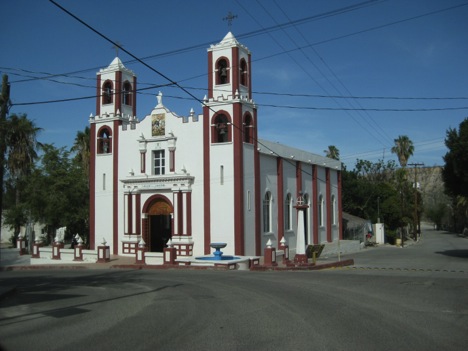 By David Kier
By David Kier
www.vivabaja.com
Co-author of ‘The Old Missions of Baja & Alta California, 1697-1834’
In July, 1721, Padre Ignacio María Nápoli, sailed south from Loreto to La Paz to begin his exploration for a new mission site between La Paz and Cabo San Lucas. Padre Jaime Bravo of the La Paz mission joined Nápoli on the expedition. The two priests spent eight difficult days traveling overland to reach the gulf shore at Ensenada de las Palmas (today called ‘Bahía de Palmas’). There they believed the Cora Indians would be awaiting conversion. After many days waiting to gain their confidence, a group of Indians led by a tall ‘sorcerer’ painted with black and red stripes confronted Nápoli on the beach. This ‘savage’ wore a cape of hair tufts and a girdle of many dangling deer hoofs. In one hand he held a fan made of feathers and in the other, a bow and arrow. Gifts were presented and the Cora Indians promised to return with more ‘friends.’ Nápoli considered this first contact a success and returned to La Paz to gather supplies for a new mission. Some writers have called this event the founding of Mission Santiago or Mission Ensenada de las Palmas, but it was simply a fact finding expedition.
The trail between La Paz and Bahía de las Palmas was long and difficult, so Nápoli decided a mission should first be located midway between La Paz and Ensenada de las Palmas. In 1722, Padre Nápoli began building his first mission near a place locally called Marinó, and he named the location ‘Santa Ana.’ This is where Jaime Bravo’s soldier, Ignacio de Rojas, had discovered silver ore two years earlier. Two adobe rooms were built to serve as a chapel and a home for the padre. By 1723, Nápoli had collected enough food to feed the workforce needed to build a larger church at Santa Ana. The mission was called ‘Santiago de los Coras.’ A storm hit the region and the people took refuge inside the uncompleted church. A wall collapsed upon them, killing and injuring many. The padre and his soldiers were unharmed. The relatives of those dead or wounded soon placed blame on Nápoli and the Spaniards. Padre Nápoli was forced to quit the Santiago mission project and returned to Loreto, to regain his confidence to try again. Nothing remains of the Jesuit church at Santa Ana, located a few miles south of the town of San Antonio.
In 1724, Padre Ignacio Nápoli did indeed begin again to build a new mission, but this time south of the Cora lands and into the land of the Pericú, at a place they called Aiñiní. Jesuit papers describing the new location were not well known until 1973, so writers have erroneously called the new mission by the old name ‘Santiago de los Coras.’
Aiñiní was well watered and the new mission, now called ‘Santiago el Apóstol,’ prospered for many years. In 1726, Nápoli was transferred to Sonora and his replacement was Padre Lorenzo José Carranco. In October of 1734, after much unrest at the four southernmost missions, the Pericú Revolt began. Padre Carranco and two servants were killed during the uprising. The mission was vacant for over a year while the Jesuits with additional Spanish soldiers and friendly Indians regrouped. Only a few foundation stones remain today at the 1724 mission site, on private land.
In 1736, the mission was moved about two miles south and rebuilt. In 1748, the mission at San José del Cabo was closed and became a visita (visiting station) of Santiago. San José was reopened as a mission by the Franciscans in 1768. Epidemics eventually plagued Santiago, as it had the other missions, and by 1795, the mission was closed and the 40 remaining neophytes were transferred to San José del Cabo. Some writers have said the mission was moved one additional time in 1790 to the visita at Caduaño, about 10 miles south.
David Kier is co-author of ‘The Old Missions of Baja & Alta California, 1697-1834’. The book is available for purchase HERE or at the DBTC offices (call 800-727-2252).





